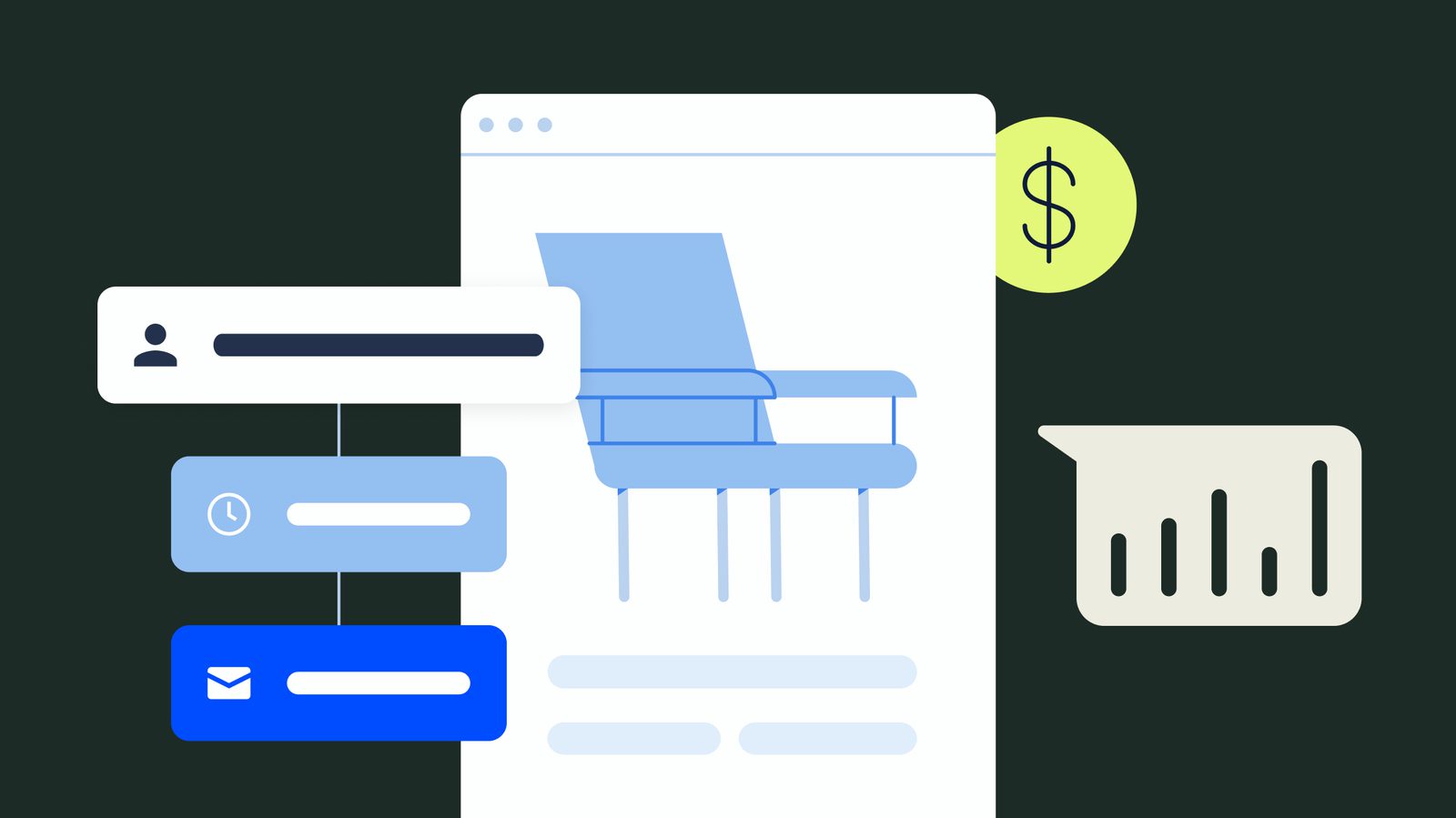It’s widely accepted that inbound sales and marketing teams are the holy grail for revenue growth in software startups.
Yes, outbound has its place, but inbound delivers higher intent leads and puts the power of the sales process in the customer’s hands.
However, for this process to be effective, you need a powerful lead generation strategy that attracts new buyers but doesn’t come across as overly sales-y.
A pretty delicate balance, right?
In this article, you’ll learn everything you need to know about lead generation, from defining what a “lead” even is to 5 powerful channels for capturing new prospects.
Table of Contents
What is lead generation in digital marketing?
In digital marketing, lead generation is the process of attracting potential customers and capturing their contact details to enter into your CRM or sales platform.
Many of your marketing efforts will focus on building awareness for your brand, your product, and the problems you solve for your customers.
At some point, you need to start engaging in a one-on-one conversation with each customer, which is why we generate leads, so that our marketing or sales teams can initiate this contact.
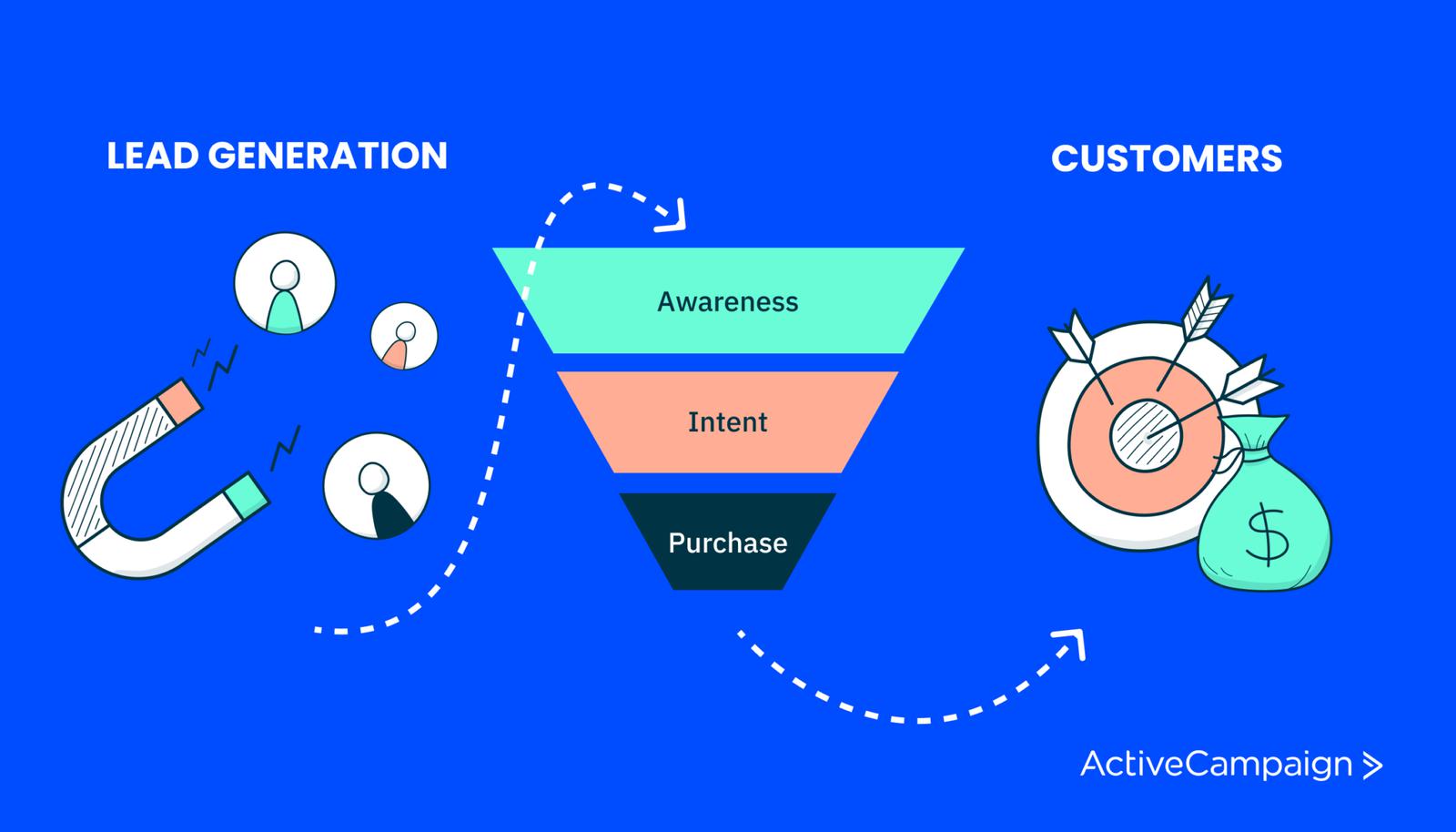
Let's look at an example.
Say your primary channel for customer acquisition is SEO. You’ve developed a ton of educational, insightful, and actionable blog posts that help readers solve problems related to your industry and solution and subtly point toward your product.
At the end of the blog post, you’ll place a lead generation magnet—a valuable content asset that customers can have for free, as long as they hand over their email address.
Take this example from Demodesk.
At the end of a sales-related blog post, they drop a content upgrade: a free webinar on running discovery calls.

This lead magnet creates a win-win situation: readers get access to more high-quality content, and Demodesk gets a potential sales lead.
Defining what a “lead” is
One of the problems many sales and marketing teams face is defining what a "lead" actually is.

Referring to the previous example, our goal was to generate leads through an ebook offer. Here, we’re capturing a customer email address, nothing more.
Can we consider this a lead?
In many marketing circles, the answer is yes. But for sales teams, it's unclear whether this customer has any true buying intent.
Does a reader who downloads an ebook on sales performance management necessarily need Demodesk’s product?
There is no intent signal here: perhaps the reader downloaded the ebook to feature as a lead generation example in an article they’re writing, in which case they’re not a suitable lead at all.
For this reason, we separate leads into 3 categories:
- Marketing Qualified Lead (MQL)
- Product Qualified Lead (PQL)
- Sales Qualified Lead (SQL)
1. Marketing Qualified Lead (MQL)
A marketing-qualified lead is someone who has:
- Interacted with your marketing content
- Demonstrated purchase intent
So, a lead generated through a downloadable lead magnet meets the first requirement but not the second.
Whether or not the lead has demonstrated purchase intent will depend on how you define intent. For instance, some companies might consider visiting the pricing page as a purchase intent signal.
Others are happy to consider engagement with additional content (for example, the lead nurturing emails you send out after capturing a lead) to be sufficient intent.
2. Product Qualified Lead (PQL)
A product-qualified lead is someone who has engaged with your product and received value from it.
Generally speaking, this is someone who has accessed a free trial (or is using the freemium version of your product) and is actively using it.
Note the second requirement (received value from it), implying that a lead who signs up for a free trial but doesn’t actually dig into the platform wouldn’t be considered a product-qualified lead.
Marketing teams generally set specific activities that demonstrate intent. For example, if that lead invites another user to the platform or creates a custom pipeline in a CRM tool.
3. Sales Qualified Lead (SQL)
Sales-qualified leads are the most qualified of all types; they’ve demonstrated that they’re ready for a sales pitch or demonstration.
We often use lead-scoring parameters to measure this. For instance, we might say that a lead is sales-qualified if they have:
- Engaged with 3 pieces of content (such as webinars, ebooks, and checklists)
- Accessed a free trial
- Met our Ideal Customer Profile parameters
Why is lead generation important for marketing and sales teams?
At this point in the conversation, this question usually appears:
“Can’t we just buy leads?”
Yes, you can, and that is something that businesses do. But buying lead lists comes with a ton of drawbacks:
- There is no intent—they’ve never even heard of your (probably)
- Lead lists are generally old and out of date - between a quarter and half of the list will be useless
- You’re not building a funnel of incoming leads—you get 10,000, run through them, then you need to buy another
That’s not the only reason lead generation is important for sales and marketing teams.
Inbound sales team pipelines run on leads
For inbound sales teams, leads are your lifeline.
Your entire sales process is built around nurturing leads through the pipeline, but you can’t even start if you don’t have leads filling up the pipeline.
More than that, lead generation efforts are about consistency.
One of the biggest issues with effective, reliable revenue growth is pipeline consistency.
Sales reps naturally spend more time on existing opportunities, so you get this fluctuation throughout the quarter where reps focus on closing, revenue grows, then they run out of opportunities and have to go back to prospecting (so revenue drops back down).
When leads are constantly entering the pipeline, sales reps can (either by automation built into their sales engagement software or by their sales manager) start engaging immediately, keeping lead volume consistent at all pipeline stages.
High-intent leads convert more easily than low-intent leads
Lead generation’s focus is on capturing high-intent opportunities.
That is, how do we find and attract those customers who are most likely to need and want our product?
Lead lists deliver low-intent leads; there is no signal that they are interested in buying. But inbound lead generation (when coupled with appropriate nurturing and scoring processes) provides the opposite: high-intent leads who are ready to engage with a sales agent.
Lead generation-focused marketing puts the customer first
In this structure, customers are the ones who give consent for content.
They choose to hand over their contact details (rather than receiving an unexpected phone call), and they opt into specific communications from your company.
This puts the buying process in the customers' hands, so they feel more comfortable engaging (and ultimately shopping) with you.
5 lead generation channels
So, we know capturing leads is important, but where exactly does this process take place?
1. Content marketing
Content marketing is a broad approach; it really encapsulates many different channels and tactics. For instance, all of the below are considered part of the content marketing world:
- Ebooks
- Video guides
- Webinars
- Blog posts
- White papers
- Gated content
The overall point is this:
You put out a lot of free content designed to educate readers and position your brand as an authority, industry leader, and trusted advisor.
Then, as the buyer moves through their customer journey, they’ll need more in-depth resources (i.e., they’ll move from blog posts into wanting to watch a webinar), and that’s where you generate the lead.
2. SEO
SEO (search engine optimization) is all about getting found in Google (and other search engines).
It goes hand in hand with content marketing; every piece of written content you create should be optimized for search.
This article itself, for instance, targets the keyword “lead generation,” as well as related phrases like “B2B lead generation” and “inbound lead generation process.”
You’ve likely come across this post by searching 1 of those phrases. That’s the power of SEO!
3. PPC
PPC (pay-per-click) is another channel for generating leads through search engines, this time through advertising.
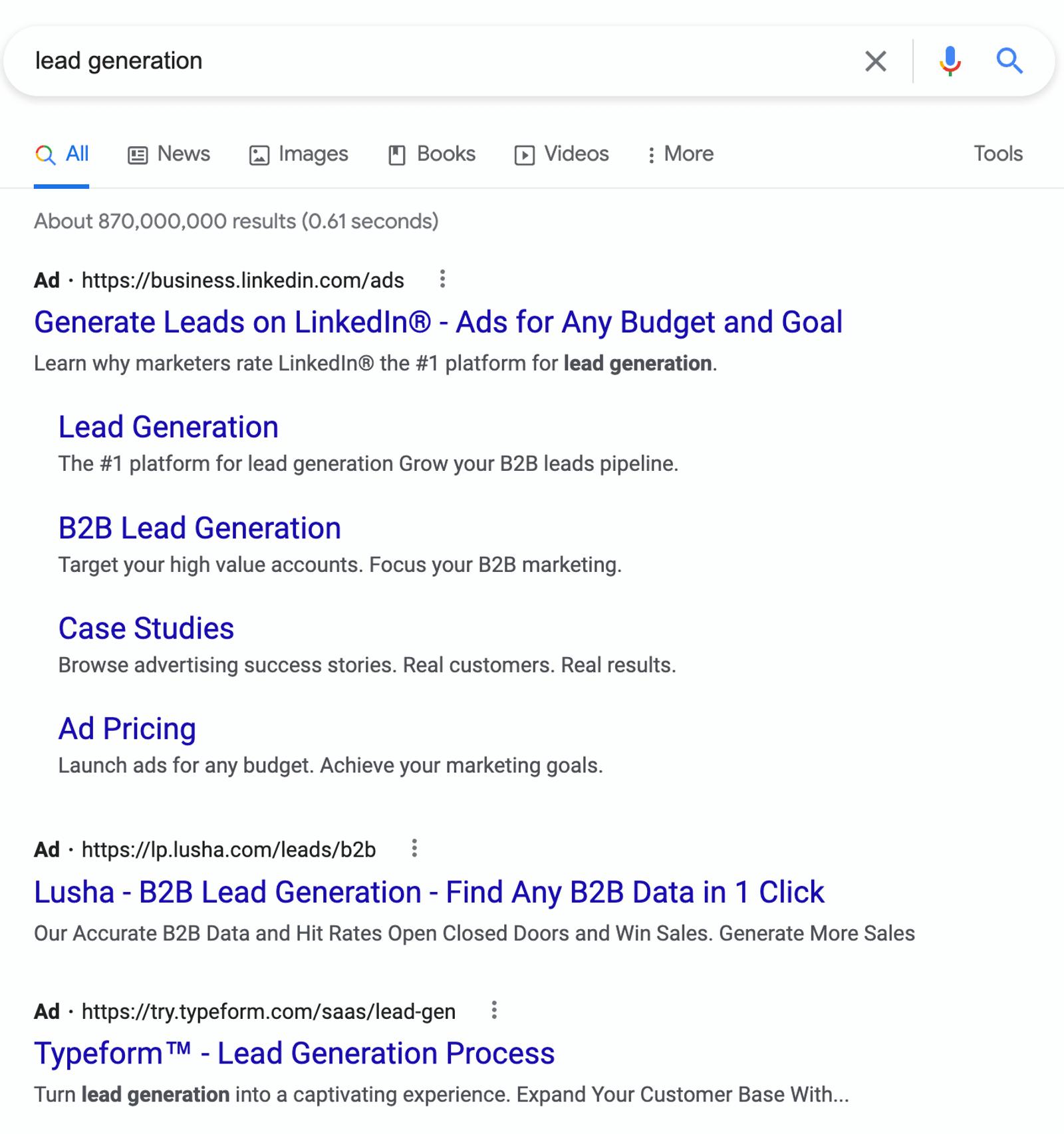
You might run Google Ads for a certain key search phrase, positioning your result above any organic search result.
For example, the social media platform LinkedIn and lead generation software Lusha both advertise for the keyword “lead generation.”
4. Social media
Social media campaigns can be a great way to generate leads for your business, as long as your offer cuts through.
Take this sponsored Facebook ad from Instapage.

The effectiveness of this ad depends on the sales funnel stage the reader is at.
In this case, I’ve viewed a lot of different content on Instapage’s site, so they’re banking on the notion that I’m more of a mid-funnel lead and would be persuaded by a downloadable case study.
However, if this ad were served up to someone who had never heard of Instapage, it would be far less effective.
5. Digital advertising
Digital advertising is essentially running banner ads on other companies' websites.
It’s an excellent way to grab attention, but it works best if you advertise on a super-relevant website.
For instance, this digital ad for Postclick appears on a weather forecast site.

Being a digital advertising platform, Postclick would likely see better results running this ad on a site like Adweek, which caters specifically to its target audience (digital marketers).
How does the lead generation process work?
Lead generation is a very specific activity—it’s the part of the customer journey where the buyer hands over their details (usually an email but sometimes a phone number) in exchange for some kind of offer (like an ebook).
There are, however, a few steps that typically come before that point.
Here, we’ll look at a simple model for this process, covering 3 core activities:
- Attract
- Engage
- Convert

1. Attract
The attract phase is where the customer first becomes aware of your brand (that is, you attract them).
Often, this is through some form of organic content.
For example, this LinkedIn post from Toggl Hire might capture your interest.

2. Engage
Now, our buyer starts engaging with our content.
Maybe they see us pop up on LinkedIn a few more times and click through on a link to an article we’ve recently published that speaks to 1 of their core pain points.
3. Convert
Now it's time to convert, which is the real “lead generation” part.
Your customer has been engaging with your content, reviewing blogs, and commenting on a few social media posts.
Now, they see a sponsored ad that says:
“Hey, remember that problem you had? That really big hairy one? Here’s how to solve it. Download our ebook.”
From there, it’s over to your lead nurturing sequences to move that lead through the funnel and into the hands of your sales team.
5 lead generation tips, tricks, and best practices
Want to make the most of your lead gen strategy? Review these 5 best practices and fold them into your marketing efforts to drive more leads into the sales funnel.
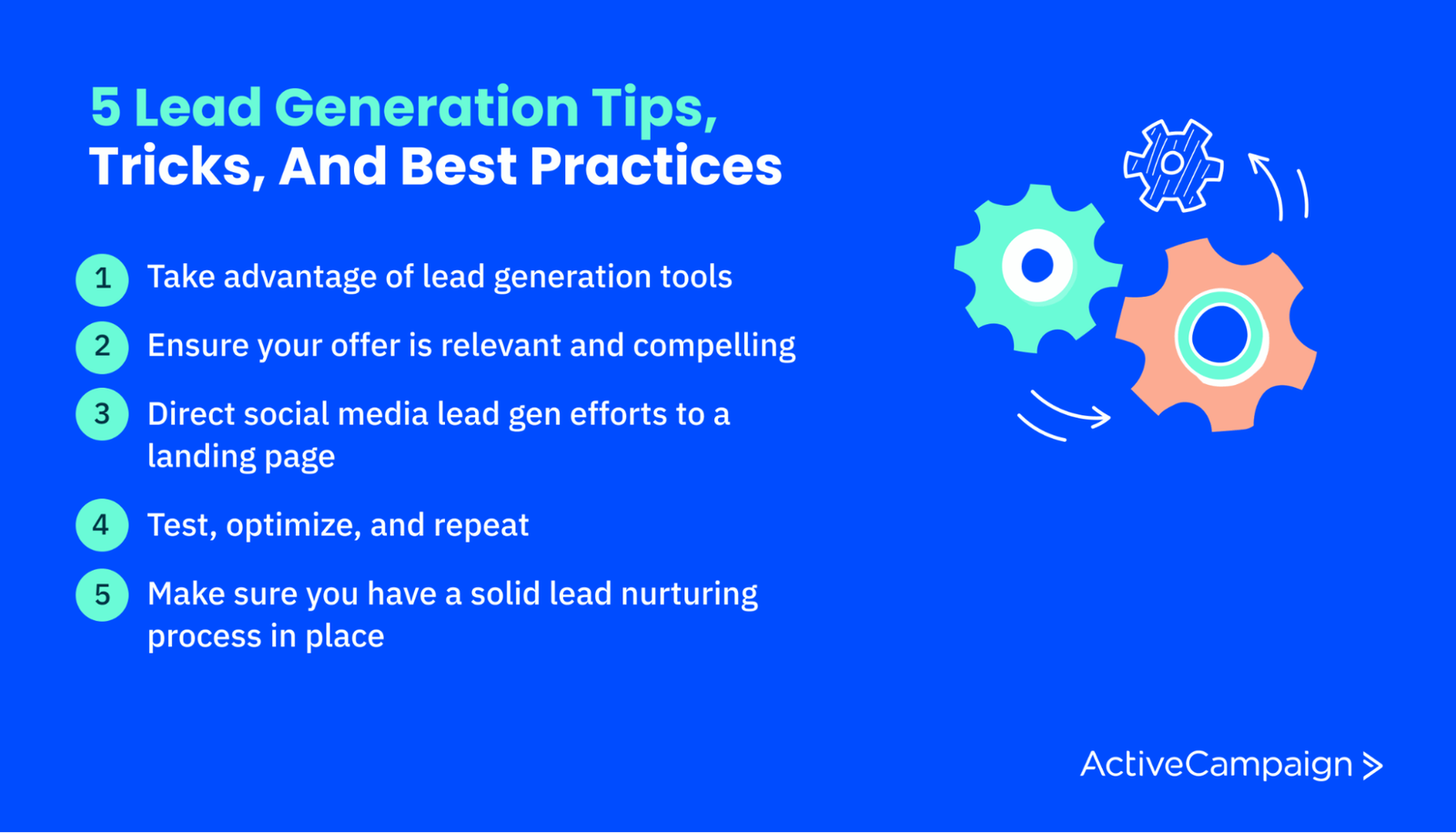
1. Take advantage of lead generation tools
You don’t have to go it alone: there are a ton of super helpful software tools out there to help you automate the lead gen process and keep your pipeline full.
For example:
- ActiveCampaign - marketing automation
- Leadfeeder - web visitor analytics
- Apollo.io - sales intelligence platform
- LinkedIn Sales Navigator - relationship-based selling
- Optinmonster - forms, popups, and gamification
- Drift - conversational chatbots
Use these innovative software tools to make your lead generation process repeatable and access key insights like which segments perform best.
2. Ensure your offer is relevant and compelling
Lead generation offers are just that: offers.
Don’t expect that because you put an ebook in front of a customer’s face, they will want to download it immediately.
Take this ad from Twilio. How compelling is an infographic with a few statistics about customer engagement?
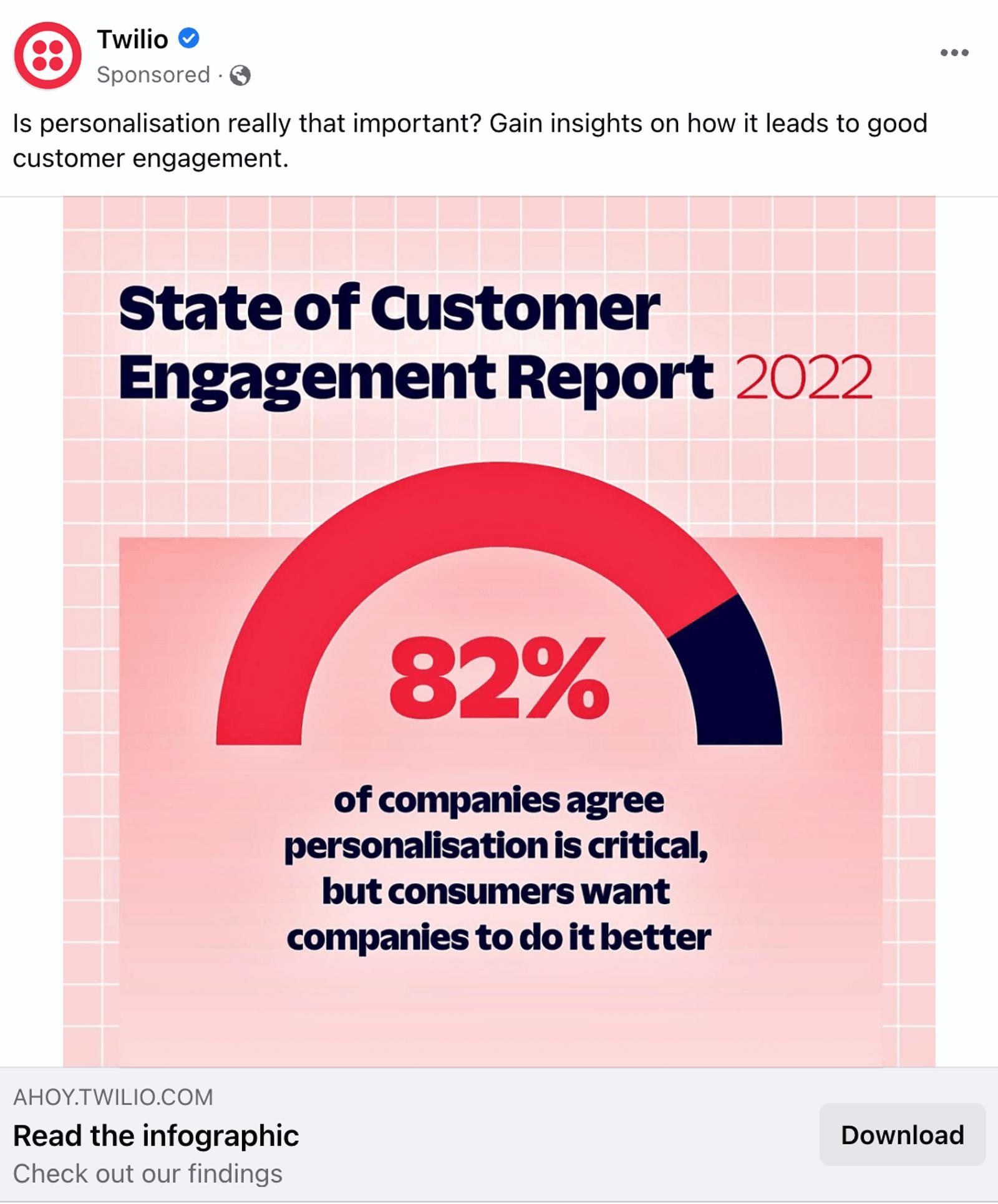
Is that an offer worth handing an email address over for, or should that be free content?
If you’re going to use gated content (like the above) to generate leads, your offer needs to be valuable and, most importantly, actionable.
Take this lead gen ad from Foundr magazine, for instance, which is much more compelling and actionable.

3. Adapt your social media lead gen approach to each platform
Running the same lead gen ad on every social media platform is largely ineffective.
These platforms each exist for a reason: they offer a different content experience for users. So, your lead gen approach should be different on each platform.
Take Subway, which uses a simple short text post with a video on Twitter.
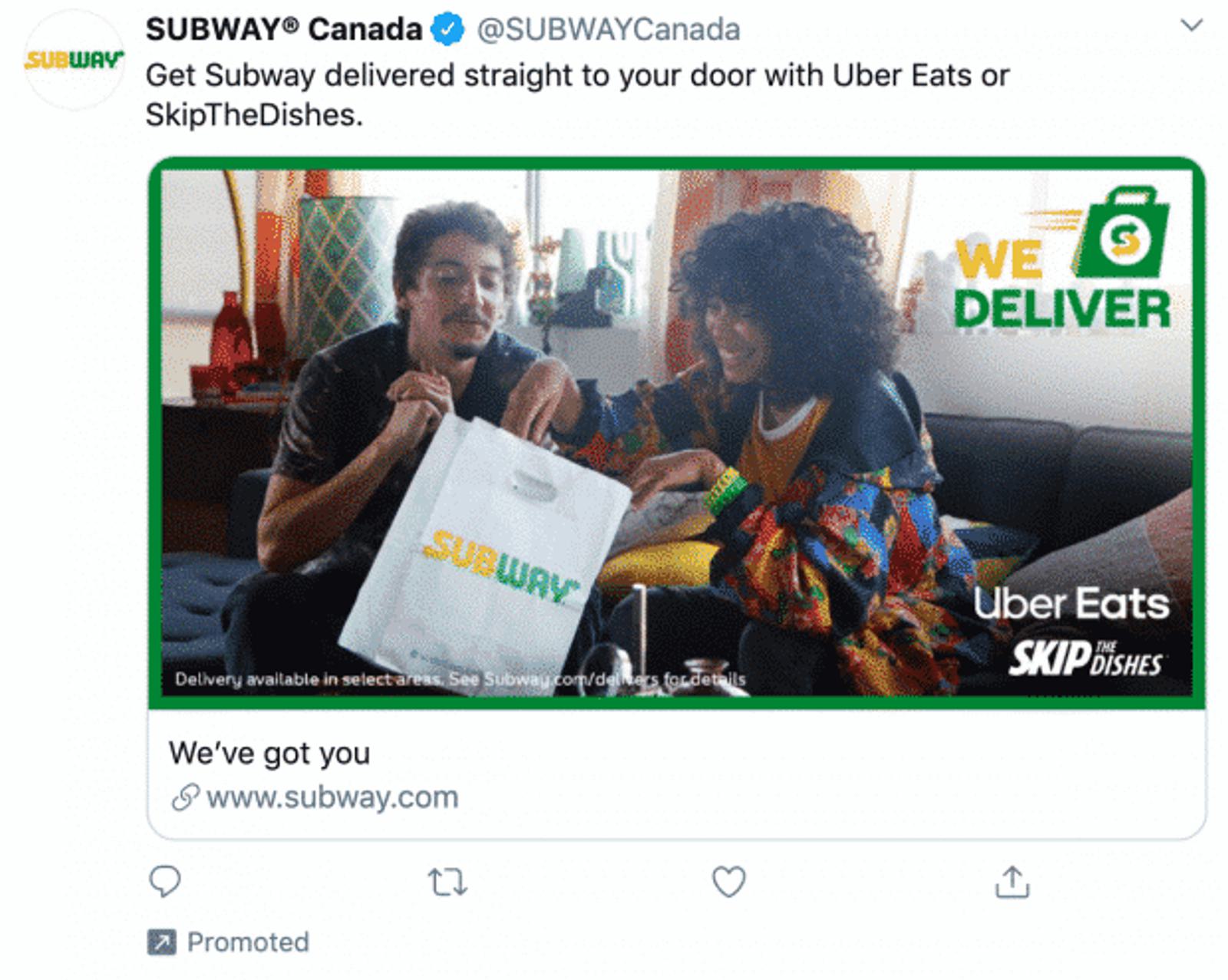
On Instagram, however, they lean into meme culture (big on Instagram), so their ads are contextually relevant.

4. Test, optimize, and scale
Despite your best customer research, analysis, and planning, you won’t know what works until you run it.
So, when you’re first getting started with lead generation efforts, be prepared to start with a bit of testing. See what works best, then double down on that.
For example, you could run 2 kinds of retargeting ads on Facebook, 1 using the carousel display and 1 using the collection display, like this ad from Dollar Shave Club.

Run both ad types with the same ad spend to the same audience, determine which works best, then run with that for the remainder of your campaign.
5. Make sure you have a solid lead nurturing process in place
Lead generation is not the final stop on the revenue-generating train.
Once you’ve captured a customer’s details, you’ll probably need to do some nurturing to get them to a point where they’re ready to engage with a sales rep.
That is, you need a solid automated lead nurturing process.
Learn more about this subject in our dedicated guide: 4 Lead Nurturing Campaigns to Earn More Customers.
Automate Lead Generation
3 quick tips for lead qualification
So, what happens once you’ve captured that lead and your potential customer’s data is sitting in your CRM?
Do they get a phone call from a sales rep? Or go into a lead nurturing email campaign?
While every company’s process will differ, implementing some lead qualification criteria is a great strategy.
Here’s how.
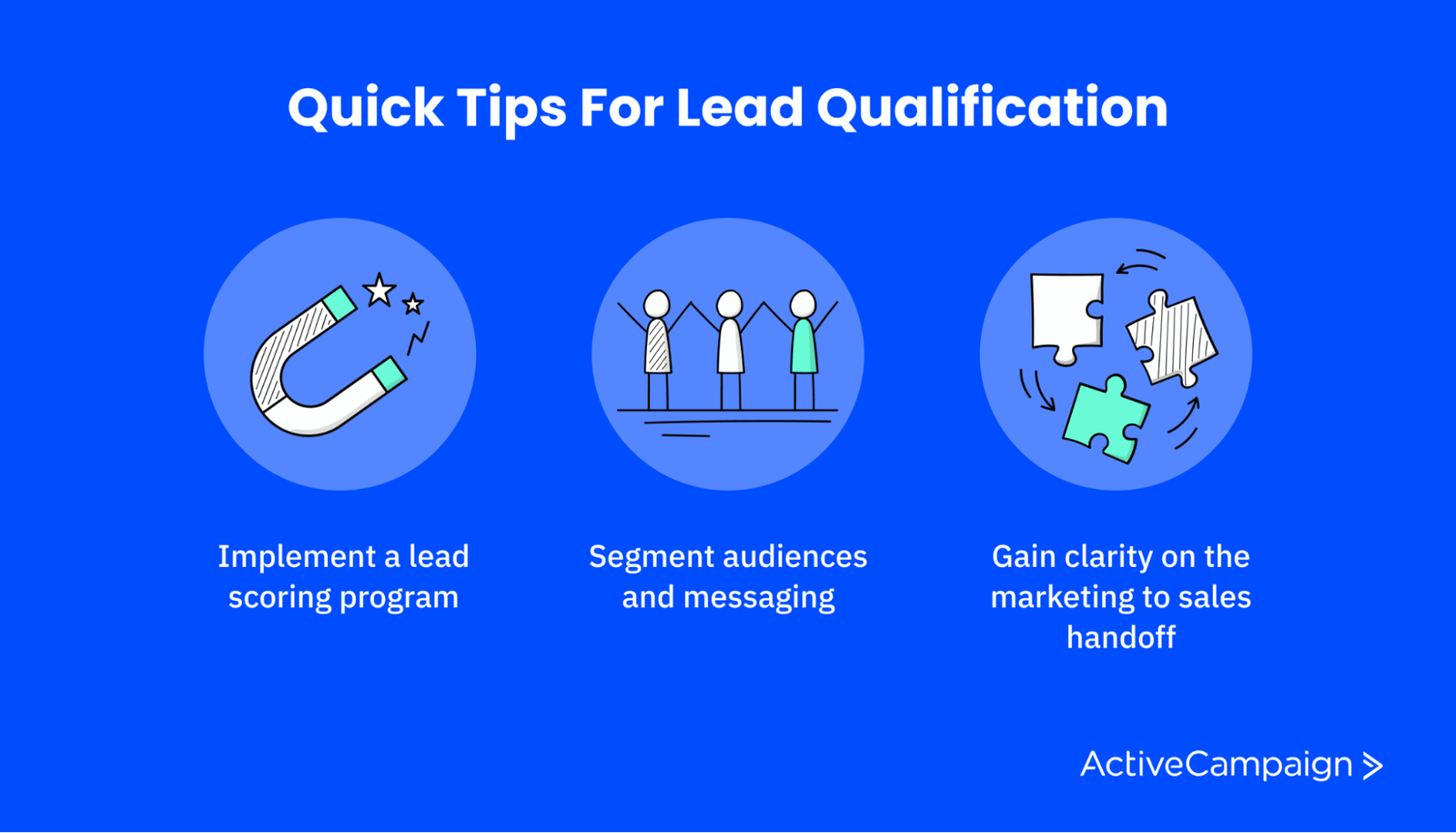
1. Implement a lead-scoring program
Lead scoring is the process of ranking and prioritizing leads as they come in, based on a few specific criteria you define.
The intention is to understand how quickly sales reps should reach out. That is, which leads are closest to buying?
For example, you might assign points based on specific actions or characteristics:
- Has watched 1 webinar
- Has annual review over $1m
- Has followed us on LinkedIn
Then, you’d set thresholds for these points. Maybe a marketing-qualified lead has 50 points, but they don’t become a sales-qualified lead until they accumulate 100 points.
2. Segment audiences and messaging
Move your leads through the funnel quickly by segmenting audiences based on specific characteristics and ensuring messaging is relevant to that specific segment.
Take Toggl Plan. They have 3 main audience segments:
- Agencies
- Consultancies
- Implementation teams
Toggl Plan should include a question on their lead gen form that asks the customer to specify which category they fall into. Then, lead nurturing sequences for agencies will be focused on agency-only problems and so on.
3. Gain clarity on the marketing-to-sales handoff
The last step is to be clear on when marketing should stop engaging with a lead and when sales should take over.
There is no handoff in some instances (such as in account-based marketing programs); the 2 teams collaborate throughout.
In others, the handoff might take place when the customer becomes an SQL, for example.
Lead generation FAQs
How do you generate leads?
The most common way to generate leads is through a content upgrade (also known as a lead magnet) like an ebook or a webinar.
Here, customers get access to premium content (not free content like your blog posts) in exchange for their email addresses.
What are the 4 steps of the lead generation process?
The 4 primary steps in any lead generation process are:
- Customer research and needs identification
- Initial contact and awareness generation through free content
- Customer engagement with content
- Lead-gen-focused ad with some form of a lead magnet (such as a downloadable guide)
What does a lead generator do?
A lead generator is a specific position on the marketing team.
They are someone whose sole responsibility is to create new opportunities for the sales and marketing team by designing compelling offers and building attractive lead-generating ads.
Conclusion
Lead generation is a crucial part of every marketing funnel, but it's not the be-all and end-all of the process.
For instance, once you’ve generated a lead, you still have a lot of work ahead of you to get that potential customer to become a paying user.
For most companies, the first step will be to engage in a lead nurturing process.
Get your own lead nurture process off the ground quickly with our free email templates.
Lead generation with ActiveCampaign
ActiveCampaign makes it easy to generate leads. Whether you're looking to set up your first lead magnet or you want to optimize your funnel, ActiveCampaign can take your lead generation tactics to the next level.
Our email marketing and automation platform helps you generate leads through forms and landing pages, and then helps you convert them with personalization and automated email marketing.
From there, our CRM can help your sales team convert those leads into sales and keep those customers coming back.
Book your demo or start a two-week trial today to get started


